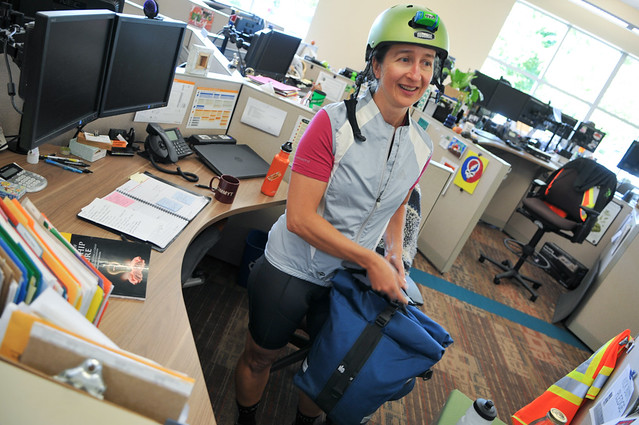
(Photo: J.Maus/BikePortland)
More and more Portlanders are choosing to bike.
That’s the great news being confirmed this year by one data point after another. The latest: a city auditor’s survey released Friday, which estimated that fully 9 percent of Portlanders bike to work during the summer — the second consecutive year of increase.
In inner Northeast neighborhoods, the bike-to-work rate is 19 percent, about twice as popular as public transit (10 percent) and more than a third of the rate for driving alone (52 percent).
The citywide figure is a bit lower than the latest Census estimate of 7 percent bike commuting as of 2014. The Census averages year-round bike commuting, while the city circulates its survey (which covers a huge range of topics) between June and August.
The auditor’s survey also estimated that drive-alone commuting is at its lowest rate on record: just 60 percent of all commutes.
Advertisement
The city also asks a question that’s not on Census surveys: over the last week, what was your primary transportation for all trips, including errands and shopping as well as work? On that measure, Portland posted a much lower 5 percent biking. That was the same ratio residents reported in 2011 and 2014, suggesting that if Portland has indeed increased bike commuting, it might have actually seen small declines in biking for non-work trips.
For the first time, fewer than two-thirds of Portlanders say that driving solo is their main way of getting around.
All citywide questions have a margin of error of plus or minus 1.7 percent.
The growth in bike commuting makes some sense given the infrastructure we’ve been prioritizing. In the last five years, by far Portland’s most significant biking investment has been its neighborhood greenway system, which is ideal for longer-distance trips along familiar routes but harder to use for shorter neighborhood trips, because it doesn’t connect well to the streets where most businesses are.
Another likely factor: since the last recession, a much larger share of new jobs and residents are landing in near the city center rather than in the suburbs. That’s probably helping boost biking by making short commutes more common, but it’s not having as big an impact on Portlanders’ other transportation destinations.
After the Census released its 2014 estimates in September, we called around to local bike shops to ask if they were selling more utilitarian bikes. Most said they were — and that 2015’s increase in bike sales had been even bigger.
— Michael Andersen, (503) 333-7824 – michael@bikeportland.org


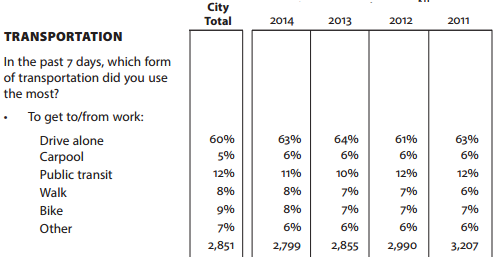
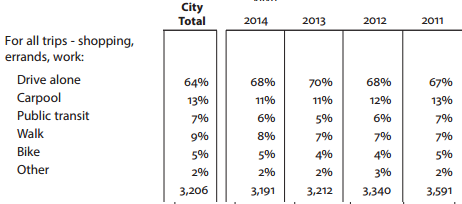
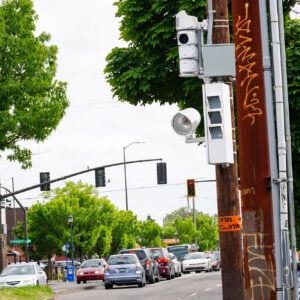
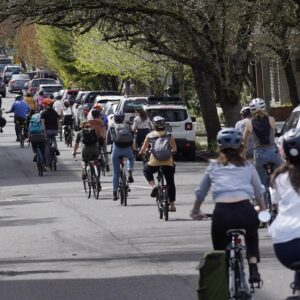

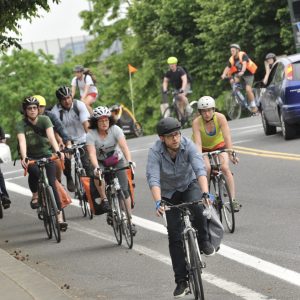
Thanks for reading.
BikePortland has served this community with independent community journalism since 2005. We rely on subscriptions from readers like you to survive. Your financial support is vital in keeping this valuable resource alive and well.
Please subscribe today to strengthen and expand our work.
“Portland’s most significant biking investment has been its neighborhood greenway system, which is ideal for longer-distance trips along familiar routes but harder to use for shorter neighborhood trips, because it doesn’t connect well to the streets where most businesses are.”
This is the next battle. Hawthorne, for example, could easily be switched to one way each direction with a center turn lane+bike lanes w/out reduction in traffic speed.
Agreed, although I’d argue that reduced car speed should be a metric of success, not something to mitigate.
Adam great point. From a practical standpoint, though, people will decry the loss of capacity. Point being we can prove via modelling that switching Hawthorne to 1×1+turnlane will not impact traffic.
“…From a practical standpoint, though, people will decry the loss of capacity. Point being we can prove via modelling that switching Hawthorne to 1×1+turnlane will not impact traffic.” johnr
What you’re saying is not clear: Are you saying it’s already been proven Hawthorne’s traffic capacity would not be impacted by such a change? Or that it ‘can be’ proven?
Though personally I feel that speed limit reduction should be step one for any Vision Zero plan, the speed limit on Hawthorne is already as low as Oregon law will allow for it – 25mph.
Yes- I realise other than the 34th – 52nd section most average around 35 mph elsewhere on the street (cough—enforcement— cough).
Much of Hawthorne could be classified as a 20 mph business district speed zone.
Reduced motor vehicle speeds are absolutely a metric that can/should be used to support street rightsizing. In fact, it’s a metric Seattle uses on its “rechannelization” projects, like 125th St.
http://www.seattle.gov/transportation/bikeprojects/ne125.htm
Curious about your thoughts on transforming Hawthorne. Do you really see Hawthorn as a good bike route? I live off it, and really don’t understand why anybody uses it as a commuter street–Lincoln and Salmon/Taylor are such better options: faster, safer, way less traffic., no lights.. It seems kind of absurd to me to try to make a street like Hawthorne into a major bike street and a major buss street and a major car street and a major pedestrian street–there’s only so much traffic/use a single street can handle and the more we add, the more problems we create.
Why not just separate the different types of traffic–put buses and bikes on their own streets, separate from cars, as much as possible? It’s nice to live in a city that is essentially a grid, with parallel streets running alongside major streets like Hawthorne. I can’t understand why we don’t take advantage of that to make parallel commuting streets for different uses. It seems much safer to me.
I lived on Hawthorne and 50th for about 14 years, just moved recently. Whenever I would head west towards downtown, I would ride on Hawthorne every time. Sometimes commuting to work, sometimes just out running errands or going to dinner or a show.
Why? Because it was the fastest and most direct route.
Salmon and Lincoln are about 10 blocks out of the way (if you count the detour off Hawthorne and back), and they’re full of stop signs. Stop signs require me to stop every time, while the traffic lights are only red some of the time, so I can maintain a higher average speed on Hawthorne. The speed limit on Hawthorne is only 25, so keeping my speed close to that of other traffic is simple, and there are extra lanes that allow faster traffic to pass me easily. If I have errands to run, they are on Hawthorne, not on the side streets; credit union, hardware store, grocery store, book store, movie theater. The side streets are narrow with poor sight lines at intersections; trying to see around parked cars makes it difficult to decide if it’s safe to proceed. These are some of the same reasons that motorists prefer Hawthorne to Salmon and Lincoln.
Why should direct and convenient routes be reserved for motor traffic only?
I think that changing from four lanes to two + turn would have a negative effect on traffic flow for all modes on Hawthorne, because of the on street parking. One fool trying to parallel park can frustrate impatient drivers and some of them will make unsafe passes to get around. The #14 bus stops frequently on Hawthorne, and if there’s not an additional lane to allow safe passing, this will complicate matters too.
The only time I would use one of the side streets is the uphill section from 12th to 30th eastbound. In that case, I use Madison and get right back on Hawthorne at 30th.
Obviously, not everyone is comfortable taking the lane and riding on Hawthorne, but for me it was the best option.
and really don’t understand why anybody uses it as a commuter street–Lincoln and Salmon/Taylor are such better options: faster, safer, way less traffic., no lights..
1. My destinations are on Hawthorne.
2. Hawthorne has signals which arguably makes crossing arterials safer and more predictable than riding on Salmon (where cyclists often have to wait for a gap in traffic).
3. Cars routinely pull out in front of cyclists on Salmon. I’ve had far more near misses on Salmon than on Hawthorne.
Hawthorne already sees significant use by people cycling and this would likely increase significantly if bike lanes were installed.
How is “Inner Portland” defined? Chavez? 82nd? I-205? I feel like “inner” keeps changing as people are priced out of closer-in neighborhoods.
In this survey, at least, it’s consistent. It’s something like Mississippi Ave to 33rd.
http://www.portlandonline.com/auditor/index.cfm?c=66565&a=551383#page=4
When these subareas were first identified, I suspect the reason for breaking Northeast into inner and outer (and lumping some of inner North into inner Northeast) was to look specifically at data for historically black neighborhoods:
http://www.upa.pdx.edu/IMS/currentprojects/TAHv3/GIS_Data/Portlands_People/PDX_Redlining_1938.jpg
Makes sense, thanks!
Welcome to America’s bicycle capital.
Yay, biking increased 1%! What’s the reliability of that data? +/- 1.7%, so maybe not?
Or it’s up 2.7 which means we could be up to nearly 11% – which I think is a more likely scenario than it being less, since the further you get out from the city center, the less reliable the numbers get.
Yeah, the Census data has a similar margin of error. But the probability that both the Census data and the city data are both off by the same magnitude — that’s pretty low.
It’d be great to be increasing biking by more than 1 percentage point a year. But if that were something we could do consistently, it’d actually be a really, really big deal. For example, it’d be enough to get us to 24 percent bike commuting by 2030, right in line with the city goals that conventional wisdom (from our mayor, for example) describes as off-the-charts optimistic.
As the article sites this figure is for during the high point in summer. It always kind of bugs me when people tout this as if it were a yearly mean of some kind when it is self evident that about 2/3 to even 3/4 of the year there are way less people riding. I’m not saying you are doing this but time and again I’ve seen people just grab that number and run with it. From my experience if its not within a pretty narrow range of 65 to 75 degrees or so and sunny then the riders dry up quick. How much this affects the overall daily numbers and yearly mean is important in characterizing the situation.
How does this survey take into account mixed-mode commutes? I.e. bike-to-Max?
It doesn’t. It’s a problem.
I know it’s not an exact science, but I couldn’t help noticing that several of the columns do not add up to 100%.
The “drive alone while talking on the phone and never signal turns” group seems to be growing. But, the tricky question is: How many of them consider that “carpooling”?
I love the optimism of this article, but an accurate headline and conclusion would be “City Survey Finds No Statistically Significant Changes in Portland Bike Commuting Rate This Year”. While the data allows for the possibility of an increase in bike commuting, as a matter of elementary statistics it definitely doesn’t show it. In fact, based on this data it’s possible that the rate decreased from 8.7% to 7.3% from 2011 to 2015.
I really want to know more about the ‘Other’
Most folks have only so much money each month. With high rents, and higher and higher taxes, fewer people can afford a car. So, poverty will push people into bicycles – just as it does around the world.
Add to those taxes our sky-rocketing health care costs – a little more money not available to feed a car. So, perhaps everyone should be taxed enough that they have just enough money left over each month for basic necessities, but not enough for a car. A sliding scale tax, that leaves each person with exactly the same take-home pay each month. In that case, what is the easiest job on the planet – that’s the one I’m going to get! 🙂
Pretty sure using taxation to bludgeon others into using your lifestyle is not why we have taxation.
In most European countries I’ve visited it costs over $3000 to get a driver’s license. And the test is HARD. Throw that in the mix and we might get higher cycling numbers, and WAY safer streets. Just sayin.